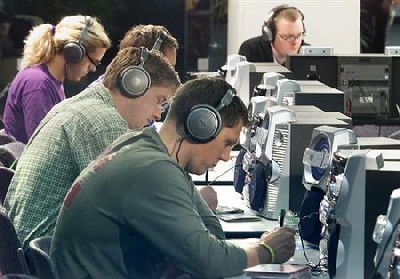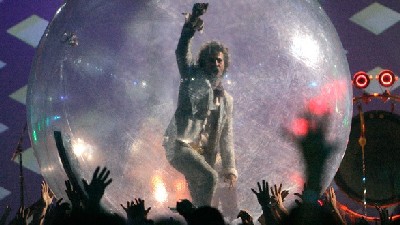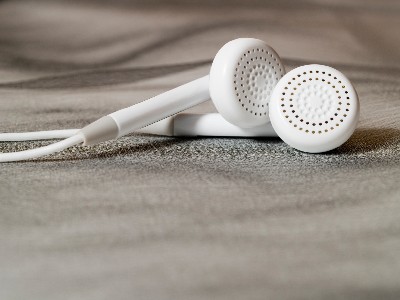Priyanka Joshi in Mumbai
Kolaveri Di, the popular viral song, made it to Airtel's 2011 top-seller charts after it was downloaded 2,10,000 times within 18 days of launch.
A survey among 170 million mobile customers of Airtel revealed they had clocked 150 million mobile music downloads last year. And, these are the numbers from just one telecom player in the Indian digital music market.
Indian music industry, estimated to be worth Rs 8.53 billion in 2010, registered a growth of 9.64 per cent over 2009. But by 2015, the share of physical revenues is expected to decline to six per cent of the total music industry revenue, according to FICCI-KPMG estimates.
A consistent volume de-growth of physical formats, coupled with factors such as price erosion, piracy, emergence of non-physical formats such as mobile value added services, has contributed to the changing revenue mix.
...
2012: The year of digital music
Photographs: Juergen Schwarz/Reuters
The music industry is expected to grow at a CAGR of 17 per cent to Rs 18.66 billion by 2015, with digital music acting as a key growth driver.
Players like Dhingana music platform, a social music streaming service accessed by millions of users in 250 countries every month, claim free digital music will get bigger in 2012.
With a music collection of 250,000 songs available for free streaming, Snehal Shinde, CEO & co-founder, Dhingana.com reasons that with 100 million internet users in India today, expected to touch half a billion by 2015, just make it a market that's hard to ignore. Shinde's strategy is to turn music social.
"If you use Dhingana, then with one ...
2012: The year of digital music
Photographs: Reuters
Online content providers rely on various models to build their music library. A few pay the music label on per song stream basis or a minimum guarantee in addition to the per song stream and others just pay a lump sum irrespective of the song streams.
Six year ago, digital music sales overtook physical sales in Asia, the key markets being South Korea and India. The prime driver, cite experts, was the mobile phone and services like ringtones, caller back and caller ID tones, full track audio, etc. that caught the fancy of youngsters.
Since then, the industry witnessed a 28 per cent decline in sales of physical music i.e. sales via compact discs (CDs) and other physical forms netted by a significant jump of 57 per cent in digital music consumed either via download or through streaming, from internet sites and via mobile phones.
...
2012: The year of digital music
Photographs: Yuriko Nakao/Reuters
iMusti.com, an online music portal with 100,000 registered members, of which 10 per cent are paid subscribers, notes customers pay for all genres as long as content is of high quality.
Samir D Khandwala, founder & CEO, iMusti, points, "Customer like to listen to something that is not played 10 times a day on radio stations and television channels. Out of all, classical and regional music have been very popular and customers have purchased it more compared to Bollywood music."
iMusti adds this year the goal is to launch a music application that will allow subscribers to download content across all platforms.
"iMusti aims to sign partnership agreements with large corporations in all parts of the world to make the content more accessible, affordable and entertaining. We will work very closely with artist community to promote their work to fans in all parts of the world," says Khandwala.
...
2012: The year of digital music
Khandwala and Shinde agree online music streaming (across devices) will be the flavour of 2012.
"Customers do not like to download a lot of tracks because it is not easy to manage them once they have a large volume of data. It is also not easy to transfer files from one device (e.g. computer to mobile) for all age group customers. Hence, we see streaming to be more commonly used over downloading," reasons Khandwala of iMusti.com.
Hungama, another leading content provider with a digital library of 220,000 songs that powers 75 per cent of all mobile entertainment content in India, is beefing up its mobile music arm in 2012.
"We see a lot of traction on the mobile download and streaming front," says Siddhartha Roy, COO (consumer business), Hungama.
...
2012: The year of digital music
With 11 per cent of Hungama's total subscriber base paying for legal downloads, Roy adds mobile subscribers are comfortable with download plans between Rs 5 and Rs 20.
Besides, last year, Hungama also launched MyPlay, an interactive music application for Facebook users.
"This social music app has allowed us to funnel a lot of young music lovers to our site, which in turn helps us in creating paid users from the free consumers," explains Roy. Facebook users can add this application to their profile page and play songs via live streaming.
On Dhingana, where users spend 30 minutes a session, Shinde underlines that mobile users have a higher stickiness. He says, "We have 2.5 million users on the web and have seen a million mobile app downloads. And, while 60 per cent of our mobile users are NRIs, we see the Indian base increasing in 2012 as smartphone and mobile data expands."
...
2012: The year of digital music
Players are also ensuring they have mobile apps across platforms and devices. For instance, Hungama has a very popular music streaming and content download app for Apple devices.
"The in-app purchase on Apple App store is a great way to convert free content users to paid user base," says Roy.
Others like iMusti have rolled out apps for iOS, Android and even for Samsung Smart TV platforms. Hungama, too, is ready to roll out smart TV apps this year.
According to industry data, 80 per cent of TVs will be Smart TVs by 2013 (television sets that can connect to internet) and digital content providers are not willing to let any opportunity amiss in 2012.









article